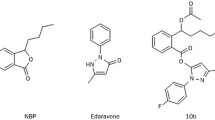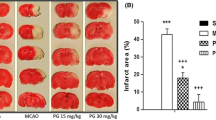Abstract
1,5-O-dicaffeoyl-3-O-(4-malic acid methylester)–quinic acid (MQA), extracted from Arctium lappa L., has been observed to exert neuroprotective effects in vitro. The aim of this study was to investigate whether MQA is an effective therapeutic method for cerebral ischemic injury in vivo. In this study, adult male rats were randomly divided into four groups: a normal group, a model group subjected to middle cerebral artery occlusion (MCAO) for 24 h, a model + MQA group (which received intragastric MQA for the 7 days prior to MCAO), and a model + positive drug group. MQA appeared to induce effects in cerebral ischemic injury in rats, by downregulating malondialdehyde, glutathione peroxidase, and nitric oxide synthase levels. Treatment with MQA significantly reduced infarcted sections. In addition, caspase-3 and Iba1 protein expression were evaluated with immunohistochemistry, and cortical cell apoptosis was assessed with terminal deoxynucleotidyl transferase dUTP nick-end labeling (TUNEL) assays. Expression of AKT and Bax, ERK1/2, P38 and Bcl-2, NFkB1, PARP, and caspase-3 was assessed with Western blotting. We found Bcl-2 and NFkB1 (p50) expressions were upregulated, whereas the expression of PARP, caspase-3, NFkB1 (p105), ERK1/2, P38, AKT, and Bax was downregulated. In conclusion, we observed MQA was an effective treatment for cerebral ischemic injury in rats.







Similar content being viewed by others
References
Abas F, Alkan T, Goren B, Taskapilioglu O, Sarandol E, Tolunay S (2010) Neuroprotective effects of postconditioning on lipid peroxidation and apoptosis after focal cerebral ischemia/reperfusion injury in rats. Turk Neurosurg 20:1–8
Atochin DN, Chernysheva GA, Aliev OI (2017) An improved three-vessel occlusion model of global cerebral ischemia in rats. Brain Res Bull 132:213–221
Brahmbhatt H, Oppermann S, Osterlund EJ, Leber B, Andrews DW (2015) Molecular pathways: leveraging the BCL-2 Interactome to kill cancer cells--mitochondrial outer membrane permeabilization and beyond. Clin Cancer Res 21:2671–2676
Cao J, Chen Z, Zhu Y, Li Y, Guo C, Gao K, Chen L, Shi X, Zhang X, Yang Z, Wen A (2014) Huangqi−Honghua combination and its main components ameliorate cerebral infarction with Qi deficiency and blood stasis syndrome by antioxidant action in rats. J Ethnopharmacol 155:1053–1060
Duan S, Wang T, Zhang J, Li M, Lu C, Wang L, Zou Y, Fu F (2017) Huatuo zaizao pill promotes functional recovery and neurogenesis after cerebral ischemia-reperfusion in rats. BMC Complement Altern Med 17:19
Edelmayer RM, Brederson JD, Jarvis MF, Bitner RS (2014) Biochemical and pharmacological assessment of MAP-kinase signaling along pain pathways in experimental rodent models: a potential tool for the discovery of novel antinociceptive therapeutics. Biochem Pharmacol 87:390–398
Fierascu RC, Georgiev MI, Fierascu I, Ungureanu C, Avramescu SM, Ortan A, Georgescu MI, Sutan AN, Zanfirescu A, Dinu-Pirvu CE, Velescu BS, Anuta V (2018) Mitodepressive, antioxidant, antifungal and anti-inflammatory effects of wild-growing Romanian native Arctium lappa L. (Asteraceae) and Veronica persica Poiret (Plantaginaceae). Food Chem Toxicol 111:44–52
Goyal M, Demchuk AM, Menon BK et al (2015) Randomized assessment of rapid endovascular treatment of ischemic stroke. J Emerg Med 49:258–259
Guo JF, Zhou JM, Zhang Y et al (2008) Rhabdastrellic acid-a inhibited PI3K/Akt pathway and induced apoptosis in human leukemia HL-60 cells. Cell Biol Int 32:48–54
Huang HM, Guo ZJ, Luo PZ (2011) Effects of aqueous extract of cinnamon on •OH and GSH-Px in the whole cerebral ischemia reperfusion injury rats. Chin J Gerontol 31:3083–3085
Jiang Z, Wang Y, Zhang X, Peng T, Lu Y, Leng J, **e Q (2013) Preventive and therapeutic effects of ginsenoside Rb1 for neural injury during cerebral infarction in rats. Am J Chin Med 41:341–352
Kernan WN, Viscoli CM, Furie KL (2016) Pioglitazone after ischemic stroke or transient ischemic attack. N Engl J Med 64:1321–1331
Koul HK, Pal M, Koul S (2013) Role of p38 MAP kinase signal transduction in solid tumors. Genes Cancer 4:342–359
Leila MN, Beitollah A, Reza A et al (2016) Effects of Arctium lappa L. (Burdock) root tea on inflammatory status and oxidative stress in patients with knee osteoarthritis. Int J Rheum Dis 19:255–261
Li Q, Guo YL, Li Z et al (2010) The interference of picroside II on the expressions of caspase-3 and PARP following cerebral ischemia reperfusion injury in rats. Chin Pharmacol Bull 26:342–345
Liang K, Ye Y, Wang Y, Zhang J, Li C (2014) Formononetin mediates neuroprotection against cerebral ischemia/reperfusion in rats via downregulation of the Bax/Bcl-2 ratio and upregulation PI3K/Akt signaling pathway. J Neurol Sci 344:100–104
Liu Y, Zhang XJ, Yang CH, Fan HG (2009) Oxymatrine protects rat brains against permanent focal ischemia and downregulates NF-κB expression. Brain Res 1268:174–180
Longa EZ, Weinstein PR, Carlson S, Cummins R (1989) Reversible middle cerebral artery occlusion without craniectomy in rats. Stroke 20:84–91
Mei L, Fan R, Li X, Wang Y, Han B, Gu Y, Zhou L, Zheng Y, Tong A, Guo G (2017) Nanofibers for improving the wound repair process: the combination of a grafted chitosan and an antioxidant agent. Polym Chem 8:1664–1671
Nai Y, Liu H, Bi X et al (2017) Protective effect of astaxanthin on acute cerebral infarction in rats. Hum Exp Toxicol 9:929–936
Predes FS, Ruiz AL, Carvalho JE, Foglio MA, Dolder H (2011) Antioxidative and in vitro antiproliferative activity of Arctium lappa root extracts. BMC Complement Altern Med 11:25
Santos ACD, Baggio CH, Freitas CS et al (2008) Gastroprotective activity of the chloroform extract of the roots from Arctium lappa L. J Pharm Pharmacol 60:795–801
Silva LMD, Allemand A, Mendes DAGB et al (2013) Ethanolic extract of roots from Arctium lappa, L. accelerates the healing of acetic acid-induced gastric ulcer in rats: involvement of the antioxidant system. Food Chem Toxicol 51:179–187
Solá S, Morgado AL, Rodrigues CM (2013) Death receptors and mitochondria: two prime triggers of neural apoptosis and differentiation. Biochim Biophys Acta 1830:2160–2166
Tian X, An L, Gao LY, Bai JP, Wang J, Meng WH, Ren TS, Zhao QC (2015a) Compound MQA, a caffeoylquinic acid derivative, protects against NMDA-induced neurotoxicity and potential mechanisms in vitro. CNS Neurosci Ther 21:575–584
Tian X, Guo L-P, Hu X-L, Huang J, Fan Y-H, Ren T-S, Zhao Q-C (2015b) Protective effects of Arctium lappa L. root against hydrogen peroxide-induced cell injury and potential mechanisms in SH-SY5Y cells. Cell Mol Neurobiol 35:335–344
Wang Q, Dai P, Bao H, Liang P, Wang W, **ng A, Sun J (2017) Anti-inflammatory and neuroprotective effects of sanguinarine following cerebral ischemia in rats. Exp Ther Med 13:263–268
**ao-Hong BA, Cai LP, Han W (2014) Effect of cilostazol pretreatment on the PARP/AIF-mediated apoptotic pathway in rat cerebral ischemia-reperfusion models. Exp Ther Med 7:1209–1214
Yaidikar L, Byna B, Thakur SR (2014) Neuroprotective effect of punicalagin against cerebral ischemia-reperfusion induced oxidative brain injury in rats. J Stroke Cerebrovasc Dis 23:2869–2878
Yao FZ, Xue RL, Wang N (2008) The relationship of apoptosis and p38 after whole cerebral ischemia-reperfusion in rats. J Clin Anesth 24:892–894
Zhao, Lian-dong, ** GR et al (2006) Effects of edaravone on content of cerebra and serum SOD, NO, MDA in rats with focal cerebral ischemia and reperfusion. J Clin Neurol 1:57–59
Zhao P, Zhou R, Zhu XY et al (2015) Matrine attenuates focal cerebral ischemic injury by improving antioxidant activity and inhibiting apoptosis in mice. Int J Mol Med 36:633–644
Zhao H, Chen Z, **e LJ et al (2017) Suppression of Tlr4/nf-κb signaling pathway improves cerebral ischemia–reperfusion injury in rats. Mol Neurobiol 4:1–9
Zhu P, Zhan L, Zhu T, Liang D, Hu J, Sun W, Hou Q, Zhou H, Wu B, Wang Y, Xu E (2014) The roles of p38 MAPK/MSK1 signaling pathway in the neuroprotection of hypoxic postconditioning against transient global cerebral ischemia in adult rats. Mol Neurobiol 49:1338–1349
Funding
This work was supported by grants from The Applied Basic Research Program of **, Jilin, China
Corresponding authors
Ethics declarations
All experimental procedures were in line with the National Institutes of Health guidelines for animal care and use experiments.
Conflict of Interest
The authors declare that they have no conflicts of interest.
Additional information
Publisher’s Note
Springer Nature remains neutral with regard to jurisdictional claims in published maps and institutional affiliations.
Rights and permissions
About this article
Cite this article
Chen, L., Liu, Dn., Wang, Y. et al. Treatment with MQA, a Derivative of Caffeoylquinic Acid, Provides Neuroprotective Effects against Cerebral Ischemia Through Suppression of the p38 Pathway and Oxidative Stress in Rats. J Mol Neurosci 67, 604–612 (2019). https://doi.org/10.1007/s12031-019-01268-1
Received:
Accepted:
Published:
Issue Date:
DOI: https://doi.org/10.1007/s12031-019-01268-1




